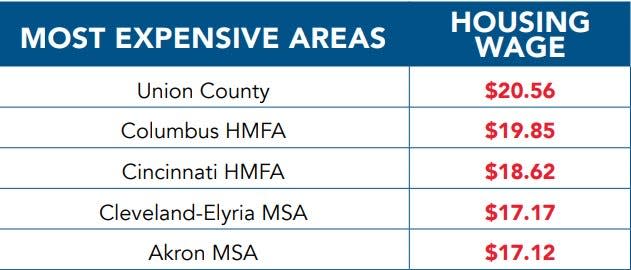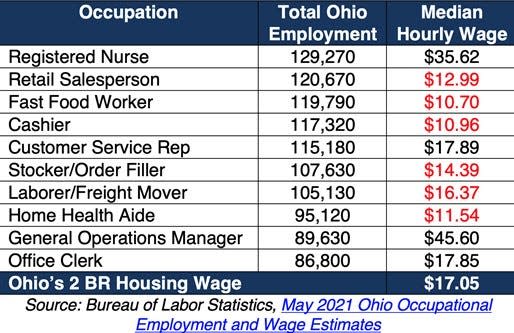'This problem continues to worsen.' Northeast Ohio renters face increasing housing costs
A full-time worker living in Stark County must earn nearly $15 an hour to afford rent on a two-bedroom apartment, according to a report on housing affordability released Thursday.
The fair market rent for a two-bedroom apartment in Stark is $768, according to the 2022 Out of Reach report, an annual study by the National Low Income Housing Coalition and the Coalition on Homelessness and Housing in Ohio. That means a worker making Ohio's minimum wage of $9.30 would need 1.6 jobs to afford rent at fair market value.
In Summit County, a full-time worker has to earn $17.12 an hour and or work 1.8 minimum-wage jobs to afford a two-bedroom apartment at the fair market value of $890.
The Akron metropolitan statistical area is the fifth most expensive in the state, following only by Union County ($20.56), Columbus ($19.85), Cincinnati ($18.62) and Cleveland-Elyria ($17.17), the report says.

What are fair market rates for Ohio apartments?
The fair market rent for a two-bedroom apartment is Ohio is $887. An Ohio worker would need to make $17.05 an hour to afford rent and utilities at this rate without spending more than 30% of their income on housing.
These numbers show the growing gap between renters' income and the cost of rent, according to the Out of Reach report.
"This report is a snapshot, and it captures the issues that renters are facing, every day this problem continues to worsen, and there's really a need for action to be taken right now," said Amy Riegel, executive director of the Coalition on Homelessness and Housing in Ohio.
Out of Reach report reveals gap between hourly wages, rent cost
Wages have increased in recent years, but rent has climbed significantly, too.
The average cost of renting a two-bedroom apartment has risen by 12.6% over the last year, according to data from Apartment List, an online marketplace for apartment listings.
Suburban and urban areas have been hit the hardest by the issue, but rural communities such as Athens, Licking, Fairfield and Morrow counties are also seeing gaps between hourly wages and rent of two-bedroom apartments.
The Out of Reach report highlights this problem, Riegel said, but "in some ways it may not fully demonstrate the significant need across the state."
Only four of the 10 occupations with the most employees in Ohio make more than the $17.05 an hour needed to afford a two-bedroom apartment, according to data from the U.S. Bureau of Labor Statistics. These positions are registered nurse ($35.62), customer service representative ($17.89), general operations manager ($45.60) and office clerk ($17.85).

"We see that more families and more individuals are being affected by these issues of rapidly rising rent," Riegel said.
Do federal housing programs need to change?
Diane Yentel, president and CEO of the National Low Income Housing Coalition, said in a prepared statement that federal housing programs such as Housing Choice Vouchers and the national Housing Trust Fund are underfunded and in need of change.
"As a country, we have the data, partnerships, expertise, solutions, and means to end homelessness and housing poverty — we lack only the political will to fund solutions at the scale necessary," Yentel said.
Riegel said the Coalition on Homelessness and Housing in Ohio has submitted a proposal to Gov. Mike DeWine and other state legislators asking the state to invest $308 million of its $5.6 billion in recovery funds from the American Rescue Plan to develop more affordable housing.
The proposal requests funding for housing programs that would focus on low-income families, seniors, people with disabilities, domestic violence survivors, families at risk for infant mortality and people leaving incarceration.
"So it is a request that really affects all parts of our community and looks at housing holistically in a way that has a long-term impact by adding more affordable housing units across the state," Riegel said.
More than 230 agencies across the state are supporting the proposal, including the Ohio Chamber of Commerce, the Akron Leadership Foundation and the Columbiana County Educational Service Center.
Reach Paige at 330-580-8577 or pmbennett@gannett.com, or on Twitter at @paigembenn.
This article originally appeared on The Repository: Northeast Ohio renters see gap between income, cost of rent
